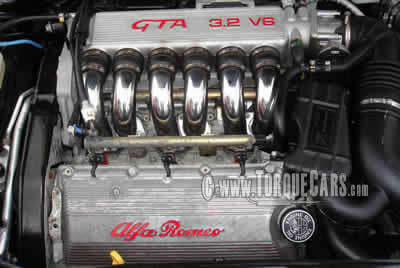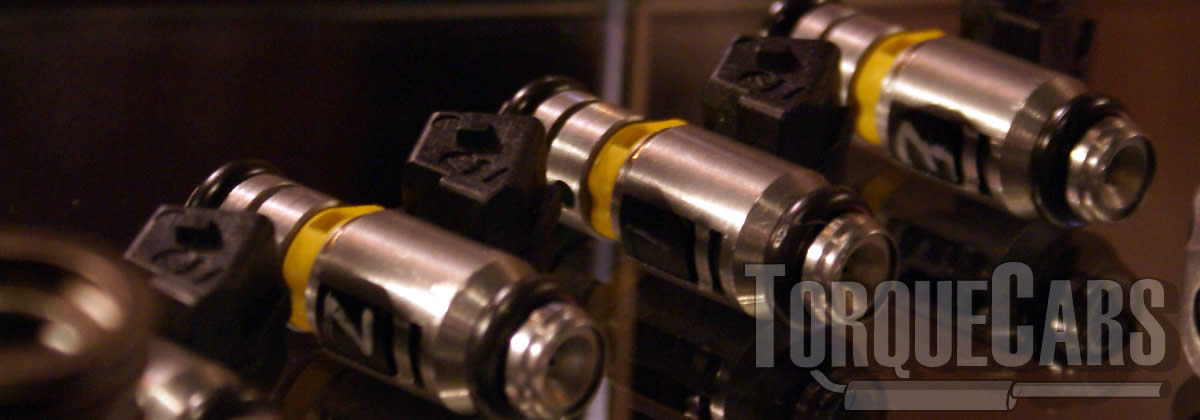Tuning the Alfa Romeo V6
"All you need to know about tuning and performance parts on the Alfa Romeo V6 engine!"
Carref prides itself on providing the latest tips and guides to your modification project.
We love the sound of this V6 and I would say it is the best sounding engine I've ever heard. I can see why there is such a following of this legendary block
This pages aim is outline options for your V6 tuning and highlight the best mods that work. Alfa Romeo V6 are popular engines and with the ultimate motorsport upgrades like ECU maps, turbo kits and camshafts you will noticeably maximise your driving enjoyment.
We consider V6 tuning and show the optimum modifications. Alfa Romeo V6 are good project engine and has been used in many kit car projects and track day cars.
We rely on our visitors to pass on tips and tell us about their projects and what worked on their car, and this article is the culmination of the feedback we have received. First let us look at the history and specs of this engine and then consider which tuning modifications work best on it.
History of the Engine
The V6 was made between 1979 and 2005 designed by Guiseppe Busso and came to be known as the Busso V6.

We see Sodium filled valves used back in 1993 when the DOHC Alfa 164 was released.
12V, two valve per cylinder versions
2.0 L 121.8 cu in (1,996 cc) 134 & 130hp Carb fed
- 1983–1986 Alfa Romeo Alfa 6 2.0 V6
- 1984–1987 Alfa Romeo 90 2.0 V6
2.0 L 121.8 cu in (1,996 cc) 207hp turbocharged
- 1991–1992 Alfa Romeo 164 V6 Turbo
- 1992–1997 Alfa Romeo 164 Super V6 TB
- 1994–2000 Alfa Romeo GTV 2.0 V6 TB
- 1998–2000 Alfa Romeo Spider 2.0 V6 TB
- 1996–2000 Alfa Romeo 166 Super V6 TB
2.5 L 152.1 cu in (2,492 cc) 156 hp with six carbs
2.5 L 152.1 cu in (2,492 cc) 164 hp with Fuel injection Bosch
- 1979–1986 Alfa Romeo Alfa 6
- 1980–1986 Alfa Romeo GTV6 (Alfa Romeo Alfetta GTV6 2.5)
- 1984–1987 Alfa Romeo 90
- 1985–1991 Alfa Romeo 75/Milano
- 1992–1997 Alfa Romeo 155
- 1985–1996 Fiat Croma
- 1987–1989 Rayton Fissore Magnum V6
2.8 L Gleich 169.9 cu in (2,784 cc) 188 hp (a Gleich tuned conversion of the 2.5)
- 1982 Alfa Romeo Alfetta GTV6 2.8 Gleich
3.0 L SA (Autodelta) 180.6 cu in (2,959 cc) 174 hp
- 1984–1985 Alfa Romeo Alfetta GTV6 3.0 SA
3.0 L 180.6 cu in (2,959 cc)
189 hp
181 hp Catalyst
207 hp Zagato version
- 1987–1991 Alfa Romeo 75/Milano
- 1988–1997 Alfa Romeo 164
- 1989–1991 Alfa Romeo SZ
- 1992–1994 Alfa Romeo RZ
- 1992–1994 Lancia Thema
- 1993–2000 Alfa Romeo Spider
24V four valves per cylinder
2.5 (2,492 cc) 24V 187 - 189hp
- 1996–2005 Alfa Romeo 156
- 1996–2007 Alfa Romeo 166
3.2 (3,179 cc) 24V 247 hp or Lancia 227hp
- 2002–2005 Alfa Romeo 156 GTA
- 2002–2005 Alfa Romeo 147 GTA
- 2002–2004 Alfa Romeo GTV
- 2002–2004 Alfa Romeo Spider
- 2003–2007 Alfa Romeo 166
- 2003–2010 Alfa Romeo GT
- 2003–2009 Lancia Thesis
Tuning the Alfa Romeo V6 and best V6 performance parts.
What are the most effective V6 mods
When talking about the best top for your V6 engine, we are going to concentrate on the upgrades that give the best value for money.
The cam profile plays a big part in the engines power output so cam upgrades make quite a large difference. The intake and exhaust durations will alter depending on the chosen cam profile, so large engines power gains are on offer for cam upgrades.

Fast road cams normally boost the bhp and torque throughout the rev band, you may sacrifice a little low end bhp but your higher rpm power will be higher.
Race cams, boost the higher rpm power band but as a result the car will not idle smoothly and low end power nearly always suffers.
For a daily driver must carefully try to match your torque band to your driving style.
I'd never find a V6 Motorsport cam is a pleasure to live with when driving in heavy traffic.

Different V6 engines respond better to different cam durations than others.
The ECU mapping and fuelling also will say much on the bhp gains you'll hit.
Altering valve durations can alter the bhp band and on most engines the exhaust and intake durations do not need to match, although most cams and tuners use matched pairs there are some advantages to extending the intake or exhaust durations.
Please watch our introduction Video tutorial to car tuning. Be sure to subscribe and support our new channel.
How to tune your car
- Improve the handling
Focus on Suspension improvements, such as coilovers and make sure the bushings are in good order and that the alignment is correct. Then focus on improving the brakes, with a big disk brake conversion kit and fast road brake pads.
- Remove restrictions
Focus on the intake and exhaust with filters being the common point of restriction in a tuned car. Intercoolers may also become restrictive on turbo engines so this may also need to be uprated.
- Burn more fuel & air
Increase the fuelling so it matches the air coming into the engine. The ratio is important so you need to improve the fuel pump and injectors, so the head mods, big valve conversions, fast road camshafts and forced induction upgrades extra supply of air is adequately met.
- Test and replace any weak parts
Weak areas are commonly the clutch, the turbocharger and pistons and crankshaft in a highly tuned engine. Makes sure these components will cope with your power aspirations.
- The Tune or Remap
A cars ECU controls the fuel, timing, spark and even the turbo in some cases, so to fully extract your gains you should remap the car last and this will fully release the power. Some cars are easy to map, and others require piggyback ECU's or aftermarket ECU's but this is the most vital step of your tuning project.
Modifying to Stage 1:
Remaps/piggy back ECU, Fast road camshaft, Panel air filters, Intake headers, Sports exhaust manifold, Drilled & smoothed airbox.
Modifying to Stage 2:
Fast road cam, Sports catalyst & performance exhaust, Ported and polished head, fuel pump upgrades, high flow fuel injectors, induction kit.
Modifying to Stage 3:
Crank and Piston upgrades to alter compression, Competition cam, Internal engine upgrades (head flowing porting/bigger valves), Twin charging conversions, Adding or Upgrading forced induction (turbo/supercharger), Engine balancing & blueprinting.
Mapping helps unlock the full potential of all the tuning parts you've done to your V6.
It will usually give around 30% more power on turbocharged vehicles and you can expect to see around 15% on NASP engines, but figures achieved usually depend much on the tuning parts you've carried out and the condition of your engine.
Feeding more fuel and air into the V6 engine is the whole point to any tuning project.
Air Intake manifolds flow the air during the suck phase from the filter and allow it to be pulled into the engine cylinders with fuel for the squish phase.
Shape and rate of flow of the Intake headers can make a noticeable change to fuel atomisation on the V6.
Commonly we find the air intake manifolds are in dire need of performance upgrades, although a few car makers provide well optimised air intake manifolds.
Increasing the V6 valve size, carrying out port work and head flowing will also boost bhp and torque, and importantly will give you an improved bhp and torque increase on other upgrades.
Which turbo upgrades are best?

NASP engines need quite a lot of work when you add a turbo, so we have a separate guide to help you take into account the pros and cons of going this route on your V6 and we would strongly caution against this, there are other ways to tune this lovely engine.
The more air you can get into an engine, the more fuel it can burn and uprating the induction with a turbocharger upgrade makes impressive power gains.
We see many people spending a loads of money on turbocharger upgrades on the V6 only to have the engine block explode when it's finished.
Large upgraded turbo units commonly experience no power at low rpm, and little turbo units spool up much more quickly but won't have the peak rpm bhp gains.
It is common that there is a limitation in the air flow sensor MAF/MAP on these engines when a lot more air is being fed into the engine.
You'll see that 4 bar air sensors coping with quite large power gains, whereas the OEM air sensor was restricting torque at a much lower level.
Adding a supercharger or additional turbo will make large bhp gains, although more difficult to configure. We have this feature on twinchargers if you want to read more.
Fuelling
You will need to ensure that the engine is not starved of fuel so should look at the fuelling when you start going beyond 20% of a bhp increase. It makes sense to over specify your injector capacity.
It makes sense to over specify your injector capacity.
The accepted safe increase is to add 20% to the flow rate when fitting an injector, which takes into account injector deterioration and affords you some spare capacity should the engine need more fuel.
We think this one is common sense, but you'll need to match your fuel injector to the type of fuel your car uses as well.
Choosing the right performance exhaust
One of the most common mistakes and problems we see in tuning projects is usually down to the exhaust, or rather a poorly chosen exhaust for your engine.
You only need to to replace your exhaust if your exhaust is actually causing a flow problem.
On most factory exhausts you'll see the exhaust flow rate is still ok even on modest power gains, but when you start pushing up the power levels you will need to get a better flowing exhaust.
Sports exhausts can help equal out the flow of air through the engine.
But if your exhaust is too large, ie: over 2.5 inches bore, you will lose much of the exhaust flow rate and end up lacking power and torque.
Usual exhaust restrictions come around the filters installed, so adding a faster flowing sports alternative will help avoid this restriction.
Weak spots Issues & problem areas on the V6
The V6 engines are generally reliable and solid as long as they are regularly serviced and maintained.
Regular oil changes are vital on the V6, especially when tuned and will help extend the life and reliability of the engine.
For more information on Tuning your V6 engine please join us in our friendly forum where you can discuss tuning options in more detail with our worldwide members, or read our tuning articles to get a full grasp of the benefits and drawbacks of each modification.
Please help us improve these tips by sending us your feedback in the comments box below.
We love to hear what our visitors have got up to and which upgrades work best for them on each model of car. Comments are used to improve the accuracy of these V6 articles which are continually updated.
If you liked this page please share it with your friends, drop a link to it in your favourite forum or use the bookmarking options to save it to your social media profile.
Check out TorqueCars new YouTube channel, and see their awesome new content...
Feedback
Please use our forums if you wish to ask a tuning question, and please note we do not sell parts or services, we are just an online magazine.
Help us improve, leave a suggestion or tip
